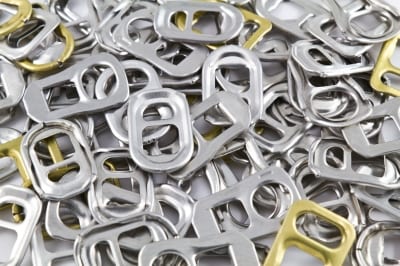 Aluminum recycling is far less expensive and energy intensive than creating new aluminum through the electrolysis of aluminum oxide which must first be mined from bauxite ore and then refined. Recycling scrap aluminum requires only 5% of the energy used to make new aluminum. Ranking first in the world, Brazil recycles 98.2% of its aluminum production, equivalent to 14.7 billion beverage cans per year.
Aluminum recycling is far less expensive and energy intensive than creating new aluminum through the electrolysis of aluminum oxide which must first be mined from bauxite ore and then refined. Recycling scrap aluminum requires only 5% of the energy used to make new aluminum. Ranking first in the world, Brazil recycles 98.2% of its aluminum production, equivalent to 14.7 billion beverage cans per year.
Remelted Al scrap in the form of used beverage cans, has been used, in conjunction with TiH2 blowing agent, to produce Al foam. A few years ago, a study reported that the scrap, via the oxides introduced from their surfaces, acts as a viscosity thickener, aiding foaming. However, highly distorted cell structures were observed and attributed to inhomogeneous distributions of the introduced oxides. The agglomerated oxide particles introduced could not act as a foam stabilizer. More recently, the company Alcoa reports the development of commercial Al foam derived from scrap material made by a liquid route using CaCO3 as a foaming agent.
Making aluminum foams entirely from scrap is attractive due to the cost savings offered by a low-cost matrix and the potential for eliminating expensive and embrittling foam-stabilizing additives. This is the field of research of Dr. G. S. Vinod Kumar and coworkers from the Helmholtz-Zentrum Berlin, and the Technische Universität Berlin, Germany, and the University of Nottingham, UK. The aim work that they have recently published was to undertake a preliminary investigation into the expansion, structure, and stability of foams made from 100% Al alloy scrap produced via a liquid route.
The researchers used swarf in the form of millimeter-sized chips, a by-product of machining of an alloy commonly used for making automotive castings. The Al chips have been heat treated and re-melted and successfully foamed after the addition of TiH2. The high oxygen contents associated with the swarf results in large fractions of clustered and dispersed oxide films in the melt. These films enhanced the foamability of this material.
Through additional alloying with Mg and holding in the liquid state to allow reaction to take place, fragmentation and wetting of the oxides occurs. Dr. G. S. Vinod Kumar and coworkers obtained foams with low densities, good pore structures, and good stability. The use of scrap material, without costly or embrittling additives, offers a low cost route to the manufacture of high quality foams.
Image: Lavoview / FreeDigitalPhotos.net

















